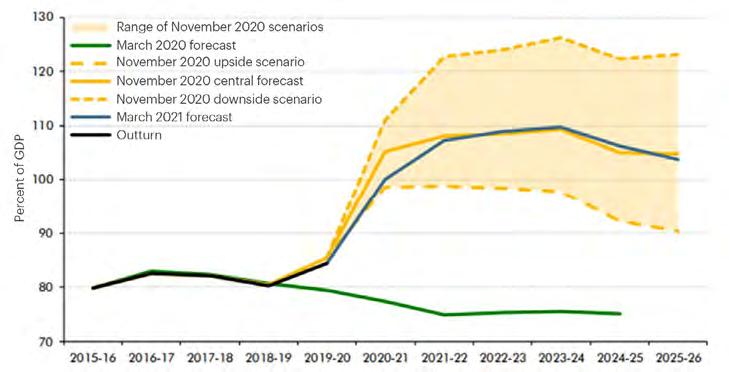BY NEAL FOUNDLY
Restoring the UK’s financial health How will the country find its way out of debt? After all the costs of the pandemic, total UK government debt now amounts to around £2,198bn. With 67,886,000 people in the country, that’s £32,378 each, please. Fortunately, there is no need to pay all this debt off in one go, but we do need to pay the interest on the loan and start to pay down some of the principal. Whilst not at a critical level yet, Britain has become more dependent on “the kindness of strangers”. The country is increasingly reliant on funding from foreign investors, which offsets our high trade deficit (whereby we import more than we export) but which could cause us bigger problems if they no longer do so and debts spiral out of control. The problem is that the debt figure is now almost 100% of income and climbing; as a nation we have around £31,400 per capita of debt which is almost up to the level of the country’s annual income of around £32,400 per capita. As we know, the lockdowns have meant the UK’s income, measured by the Gross Domestic Product (GDP), has been hit hard and fell by 10% overall in 2020 – the largest annual fall since the Great Frost of 1709. The good news is that ever since the Global Financial Crisis (GFC), interest rates have been falling in order to stimulate growth and so this is helping to reduce the interest on the debt. As a result, currently the UK’s government pays only 1.7% per annum in interest charges.
However, the story does not end there. The picture is worsening as debt continues to mount and income growth is reduced. As we can see in chart one, the Office for Budgetary Responsibility is expecting that over the next two years, debt as a percentage of income could rise to 110%. Whilst interest rates could go to zero or even negative, at the current 0.5% in the UK (a 320-year low) the country cannot rely on continually falling costs of debt to offset the rising debt pile.
How do we get out of this predicament? The Chancellor of the Exchequer, Rishi Sunak, has made it clear that public finances are on an “unsustainable” path, so how is the UK going to tackle this growing debt mountain? There are three key solutions: 1. Reduce spending 2. Raise taxes 3. Print money The first option is untenable. The UK adopted austerity following the GFC and is widely viewed as policy error rather than a solution to the country’s economic sluggish growth. Indeed, the Prime Minister has pledged not to go back to the austerity of 10 years ago, although last November’s Spending Review revealed that the government is planning to spend £14 - £17 billion less on public services each year after 2021 than was planned pre-COVID.
Source: ONS, OBR
Chart one: debt as a percentage of GDP
08












